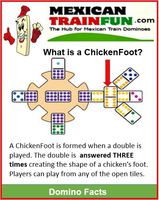 Loading... Please wait...
Loading... Please wait...Categories
BLOG - How do I play chickenfoot dominoes
How Do I Play Chickenfoot Dominoes?
Posted by Dot Domino -Mexican Train Domino Expert on 8th Jul 2015

Chicken Foot Dominoes, based on the domino game Maltese Cross, appears to have originated in Texas or Mexico. It is part of the same family of games that includes Mexican Train, and is also known as Chickenfoot Dominoes, Chicken Dominoes and Chickie Dominoes.
Players
2 or more players, best with 4 to 8 players.
Equipment
One standard set of double-nine dominoes. For games with more players, a set of double-12, double-15, or double-18 dominoes may be needed.
Goal
The goal of Chicken Foot Dominoes is to have the fewest points at the end of the final round.
Setup
Shuffle the dominoes, face down, on the table. Each player takes seven dominoes -- more if you have relatively few players and/or are using a larger set of dominoes -- and stands them on edge, so that they can see the faces (the side with the pips) but their opponents cannot.
The remaining dominoes are left on the table face down. This supply is known as the boneyard. (In Chicken Foot, the boneyard is often referred to as the chicken yard, and the tableau is often referred to as the farm yard.)
The Start Player and The First Tile
The player who drew the highest double starts the first round by placing that tile in the center of the table. For example, if you're using a set of double-nine dominoes, the double nine is the highest double.
Each later round starts with the player who has drawn the next-lowest double. For example, the player who draws the double-eight in the second round starts that round.
The final round begins with the player who draws the double-blank.
If there is a situation where no player has drawn the tile required to begin the round, players take turns drawing from the boneyard until it is found. In the case of the first round, the player who draws the start tile begins the round.
Gameplay
All dominoes must be played on one of the tableau's arms, with ends matching as in most domino games. (Example: If the start tile is a double-nine, the end of the domino the first player places near the start tile must be a nine. The other end can be anything at all.)
Play proceeds in a clockwise direction.
Dominoes must be added to all four arms of the start tile before a second domino is added to any of the arms.
If a player has no legal play, he must draw a tile from the boneyard as his turn. If that tile can be played, the player may do so immediately. If no tiles remain in the boneyard, any player without a legal play simply misses a turn.

Double Tiles
Any time a player adds a double tile to the tableau, it is placed crosswise against the arm. The player doing so must announce "chicken foot," indicating that the following special rules are now in play:
The next three tiles played must be played as "chicken toes," completing the chicken foot, before a tile can be played anywhere else. The toes are played against the double tile so that they are tilted away from the center of the tableau. (Doing so is what makes it look like a chicken foot.)
When the chicken foot is finished, gameplay proceeds normally. Players may add tiles to any open arms, including the three new chicken toes.
Ending the Hand
When one player places his final domino, or when no player has a legal play, the game ends. At this point, scores are calculated.
Scoring
At the end of each hand, the players each receive points equal to the total number of pips remaining in their hand. The double-blank tile is worth 50 points.
Winning
After all rounds have been completed, the player with the fewest points wins.If there is a tie, the player who scored the most zero-point rounds wins. If there is still a tie at this point, the player with the lowest total in a round, other than zero, wins.
